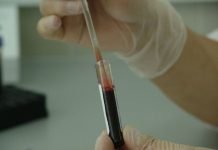
April 11 (UPI) — Scientists at an independent biomedical research institution have reported a monumental breakthrough: The cause of the primary genetic risk factor for Alzheimer’s disease, and a possible cure for the disease.
Researchers at Gladstone Institutes in San Francisco identified the primary genetic risk factor for the disease, a gene called apoE4. They were able to create a harmless apoE3-like version by inserting a class of compounds into it.
Their findings were published this week in the journal Nature Medicine.
An estimated 5.4 million Americans are currently living with Alzheimer’s disease, the leading cause of dementia and the fifth leading cause of death, according to the Centers for Disease Control and Prevention. Currently there is no cure or prevention for the irreversible, progressive brain condition, which usually develops in people after age 60.
Lead author Dr. Yadong Huang, a senior investigator and director of the Center for Translational Advancement at Gladstone, told UPI he is working with an undisclosed startup pharmaceutical company in the San Francisco Bay area to “further develop the apoE4 structure corrector approach and move toward clinic trials.”
“My lab and my collaborators are working hard to move our discovery toward clinical trials as quickly as we can,” he told UPI.
Huang said apoE4 can be targeted directly for Alzheimer’s disease drug development, but that there is no defined timetable for clinical trials.
“It is difficult to estimate when a drug could be on the market given the complexity of drug development,” Huang said. “We are likely several years away from a drug being on the market, but with concerted effort, we are working to accelerate the timeline as much as possible.
Huang said he has been working with Dr. Robert W. Mahley at the Gladstone Institutes for over 20 years on apoE and Alzheimer’s disease, especially on developing apoE4 structure correctors.
“Drug development for Alzheimer’s disease has been largely a disappointment over the past 10 years,” Huang said in a press release. “Many drugs work beautifully in a mouse model, but so far they’ve all failed in clinical trials. One concern within the field has been how poorly these mouse models really mimic human disease.”
Huang used human cells to model the disease and test new drugs.
But he told UPI that “animal models continue to be very important to test possible drug toxicity and to test the efficacy of a new drug in vivo.”
For the first time, they examined the effect of apoE4 on the human brain by creating neurons from skin cells donated by Alzheimer’s patients with two copies of the apoE4 gene, as well as from healthy individuals who also have two copies of the apoE3 gene.
Researchers said one copy of the apoE4 gene more than doubles a person’s likelihood of developing Alzheimer’s disease, and two copies increases the risk by 12-fold.
In human neurons, the apoE4 protein not functioning properly is broken down into disease-causing fragments in the cells. The process leads to issues often observed with Alzheimer’s disease, including the accumulation of the protein tau and of amyloid peptides.
Although apoE4 does not change the production of amyloid beta in mouse neurons, it increases amyloid beta production in humans.
“There’s an important species difference in the effect of apoE4 on amyloid beta,” said Dr. Chengzhong Wang, a former research scientist at Gladstone. “Increased amyloid beta production is not seen in mouse neurons and could potentially explain some of the discrepancies between mice and humans regarding drug efficacy. This will be very important information for future drug development.”
Researchers examined brain cells that did not produce either form of the apoE protein. But if they added apoE4, the cells had pathologies related to Alzheimer’s disease. So, apoE4, and not the absence of apoE3, develops the disease.
By treating human apoE4 neurons with a structure corrector, it eliminated the signs of Alzheimer’s disease, restored normal function to the cells and improved cell survival.





